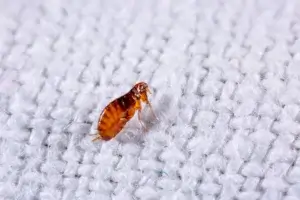
Ask a Tech: Fleas and Where to Find Them
July 25, 2019
A flea infestation is not always obviously apparent right away, but if you have outdoor pets that live in your home, they nearly always pose a threat. Fleas in the home can be a real nuisance, which is why it’s important to know the signs, symptoms, and solutions to a frenzy of fleas intruding your home; here we talk to one of our techs to get the download on everything you need to know about fleas

Q: So, let’s start off with something basic. How do fleas get into someone’s house in the first place?
A: Well, usually you’re going to have fleas getting into the home through a domesticated animal--your dog or cat can easily pick up fleas while roaming around in your yard and then carry them into the home. Once they’re in the home, fleas can easily spread because they don’t only like animal fur; they’ll also hide in carpets, rugs, and any other crevasses that they can find. Fleas want to live wherever their food source lives, and your house is just that to them.
Q: Yikes! How can you tell if fleas have infested your home?
A: Well, if you do have cats or dogs that spend a lot of time outdoors, there are a couple of telltale signs that they’ll exhibit if they’re experiencing discomfort from fleas. Be on the lookout for excessive or unusual amounts of scratching, red skin, and patchy fur. You can also see the fleas if you’re looking for them: they’re about two and a half millimeters long, with six legs, and they can jump. Sometimes, fleas will also bite humans--
Q: Wait, they bite humans??
A: Yes. It’s rare, but fleas have been known to bite people too. Their bites tend to be concentrated around the feet and ankles- the area usually most exposed during sleep- but they can also bite on the chest and legs, if you have body hair in those areas. The bites themselves are red in color and can come in groupings or lines of 3 or 4 bites per cluster. Summertime is when they peak around here, so people should be extra aware of any of these signs or symptoms.
Q: Geeze, that’s not something I’d want to experience! Can you tell us a little bit about what to do if you have an infestation? How can you get rid of one?
A: Well, there are a couple of things that you can do on your own: vacuuming the infested area and washing all sheets and clothing in hot water is a good start. There are also special treatments for pets that will help rid them of fleas for a bit. But chances are that won’t get rid of all of them, because even if you manage to get them out of your house, they got in somehow; there’s a good chance you have a flea situation in your yard, and that’s something that requires some more serious treatment.
That’s where A-1 Pest Control comes in: we’ll do an indoor and outdoor sweep of the premises to get a sense of the severity of the infestation and based on that, build a flea treatment plan. Once we get the treatment strategy solidified, we’ll apply the proper treatment to kill any fleas on the property; we want to make sure that our customers have peace of mind when it comes to any kind of infestation, so we make sure to do the job with care and resiliency. We stay in contact with the customer throughout this process, both for scheduling purposes and to provide consultation--if there are smaller measures that they can take to help make the process more efficient, we’ll let them know.
Q: Sounds very thorough. Anything you’d like to add before we finish up?
A: Just this: be mindful of signs of fleas, especially with the summer heating up. They come out more when it’s hot, and it’s better to catch any infestation in the earliest stages possible, otherwise the infestation will only get more and more severe. Summer is high time for a ton of pests, so just keep your eyes peeled!
